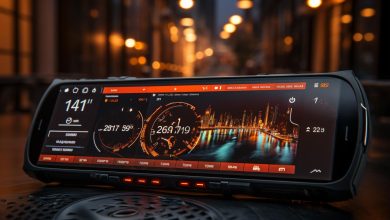Exploring Advanced Features in Running Trackers: Heart Rate Monitoring, GPS, and More

Are you ready to take your running to the next level?
In this article, we will dive into the advanced features of running trackers, such as heart rate monitoring and GPS tracking. By utilizing these powerful tools, you can enhance your training efficiency and overall running experience.
Discover how advanced data analysis and customizable training plans can help you uncover performance insights and tailor your workouts to meet your goals.
Plus, learn how syncing and integration make it easier than ever to maximize the potential of your running tracker.
Heart Rate Monitoring: The Key to Efficient Training
If you want to maximize your training efficiency, you should definitely take advantage of the heart rate monitoring feature on your running tracker. Heart rate monitoring is the key to efficient training as it provides valuable insights into your cardiovascular fitness and helps optimize your workouts.
By monitoring your heart rate during exercise, you can determine the intensity at which you are working out. This information allows you to tailor your training sessions to specific heart rate zones, ensuring that you are pushing yourself enough to make progress without overexerting or underperforming. Whether you’re aiming for endurance, speed, or fat burning, tracking your heart rate enables you to train at the right intensity level for optimal results.
Another benefit of using a heart rate monitor is its ability to provide real-time feedback on your body’s response to exercise. By keeping an eye on your heart rate, you can identify any irregularities or potential issues that may arise during workouts. This knowledge allows you to adjust your training accordingly and seek medical advice if necessary.
Heart rate monitoring also aids in tracking improvements in cardiovascular fitness over time. By comparing your heart rate data from previous workouts, you can gauge how well your body is adapting and improving with each session. This feedback is essential for setting realistic goals and adjusting training plans accordingly.
GPS Tracking: Enhancing Your Running Experience
Enhancing your running experience, GPS tracking allows you to accurately track your distance, pace, and route. With the help of advanced technology, running trackers equipped with GPS can provide valuable data that can improve your training sessions.
Here are some key benefits of using GPS tracking for runners:
– Accurate Distance Tracking: No more guessing or relying on estimates. GPS tracking provides precise measurements of the distance covered during your run, allowing you to set goals and track progress effectively.
– Pace Tracking: By monitoring your speed in real-time, GPS tracking enables you to maintain a consistent pace throughout your run. This information is crucial for interval training or trying to achieve specific time goals.
– Route Planning: With GPS tracking, you have the ability to plan and map out routes in advance. Whether you want to explore new trails or stick to familiar paths, knowing the exact distances beforehand helps in achieving desired training outcomes.
– Performance Analysis: After each run, GPS trackers generate detailed reports that analyze various aspects of your performance such as elevation changes and splits at specific intervals. This analysis provides valuable insights into areas where improvements can be made.
By utilizing GPS tracking features in running trackers, you can enhance your overall running experience while improving performance through accurate distance measurement, pace tracking capabilities, route planning options, as well as comprehensive performance analysis tools.
Advanced Data Analysis: Uncovering Performance Insights
Uncovering performance insights, data analysis allows you to gain valuable information about your training sessions and identify areas for improvement. By leveraging the power of technology in running trackers, you can track and analyze various performance metrics to optimize your training.
Here is a table showcasing some common performance metrics that can be analyzed using advanced data analysis techniques:
| Performance Metric | Description | Benefits |
|---|---|---|
| Pace | Measures your speed per unit of distance | Helps you gauge your progress and set pace goals |
| Heart Rate | Monitors your heart rate during workouts | Allows you to train at the right intensity |
| Cadence | Tracks the number of steps per minute | Enables efficient running form and reduces injuries |
| Elevation Gain | Records changes in elevation during a run | Helps you understand the difficulty level of courses |
Analyzing these performance metrics provides valuable insights into how well you’re progressing towards your goals. It also helps identify areas where adjustments can be made to optimize your training routine. For example, if you notice that your heart rate is consistently high during certain workouts, it may indicate that you need to adjust the intensity or duration of those sessions.
Customizable Training Plans: Tailoring Your Workouts
To tailor your workouts to meet specific goals, you can customize your training plans based on the insights gained from analyzing performance metrics. By taking advantage of the advanced features in running trackers such as heart rate monitoring and GPS, you can optimize your workouts and create personalized routines that will help you achieve maximum results.
Here are some ways to customize your training plans:
– Set specific goals: Whether it’s improving your speed, increasing endurance, or losing weight, setting clear and measurable goals will give direction to your workouts and keep you motivated.
– Vary intensity levels: Incorporate high-intensity interval training (HIIT) or low-intensity recovery days into your routine to challenge different energy systems and prevent plateauing.
– Adjust workout duration: Increase or decrease the length of your workouts based on how much time you have available and how well-rested you are.
– Modify exercises: Swap out exercises that aren’t working for you with ones that target the same muscle groups but in a more effective way.
By customizing your training plans, you can ensure that every workout is tailored to meet your individual needs. This level of personalization will not only make exercising more enjoyable but also maximize workout optimization for better results.
Syncing and Integration: Making the Most of Your Running Tracker
By syncing your running tracker with other fitness apps and devices, you can seamlessly integrate all of your health data in one place. This allows you to have a comprehensive view of your workouts, sleep patterns, and overall wellness. However, it is important to consider the implications of data privacy when using these integrated platforms.
When syncing your running tracker with other apps and devices, it is essential to ensure that your personal information is protected. Look for platforms that prioritize data encryption and have transparent privacy policies. Be cautious about sharing sensitive information such as your location or medical history without understanding how it will be used and stored.
Additionally, syncing multiple apps and devices may impact battery life. Running trackers already consume energy while tracking your runs, so adding more connections can further drain the battery. It’s advisable to monitor battery usage closely or carry a portable charger if you plan on extended use.
To give you a better understanding of which running trackers offer seamless integration capabilities and their respective battery life performances, here’s a comparison table:
| Running Tracker | Integration Options | Battery Life |
| Tracker A | Fitness Apps | Up to 5 days |
| Tracker B | Smartwatches | Up to 7 days |
| Tracker C | Heart Rate Monitors | Up to 10 days |
| Tracker D | Sleep Trackers | Up to 14 days |
Remember that while integration offers convenience and consolidated data analysis, always prioritize data privacy and keep an eye on battery consumption when syncing your running tracker with other apps and devices.
Conclusion
In conclusion, running trackers offer a plethora of advanced features that can revolutionize your training routine.
With heart rate monitoring, you can ensure efficient workouts and track your progress over time.
GPS tracking enhances your running experience by providing accurate distance and pace data.
Advanced data analysis helps uncover performance insights, allowing you to identify areas for improvement.
Customizable training plans cater to your specific goals and abilities.
Lastly, syncing and integration capabilities ensure seamless connectivity with other devices and apps.
Fun fact: Did you know that using a running tracker can increase motivation by up to 30%?
So why wait? Start exploring these advanced features today and take your running to the next level!


